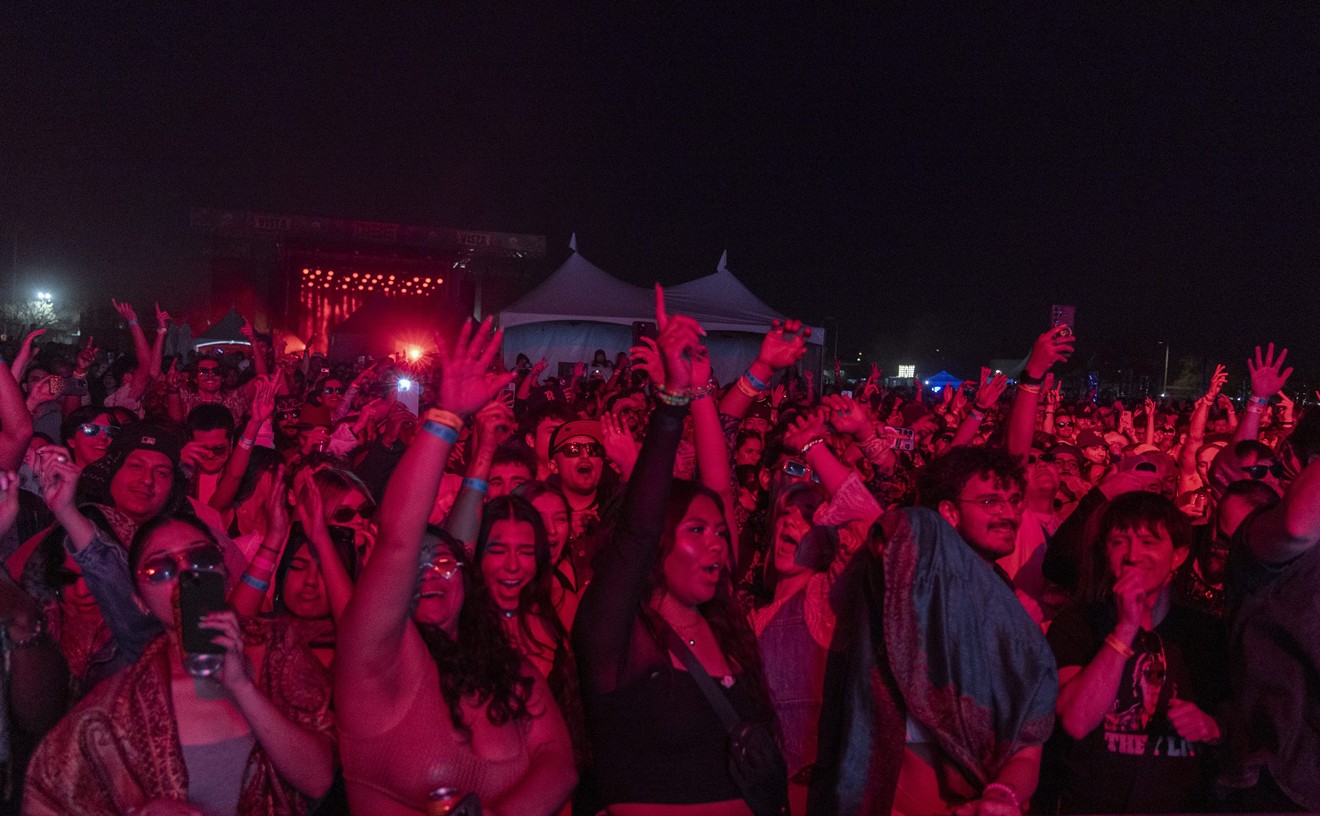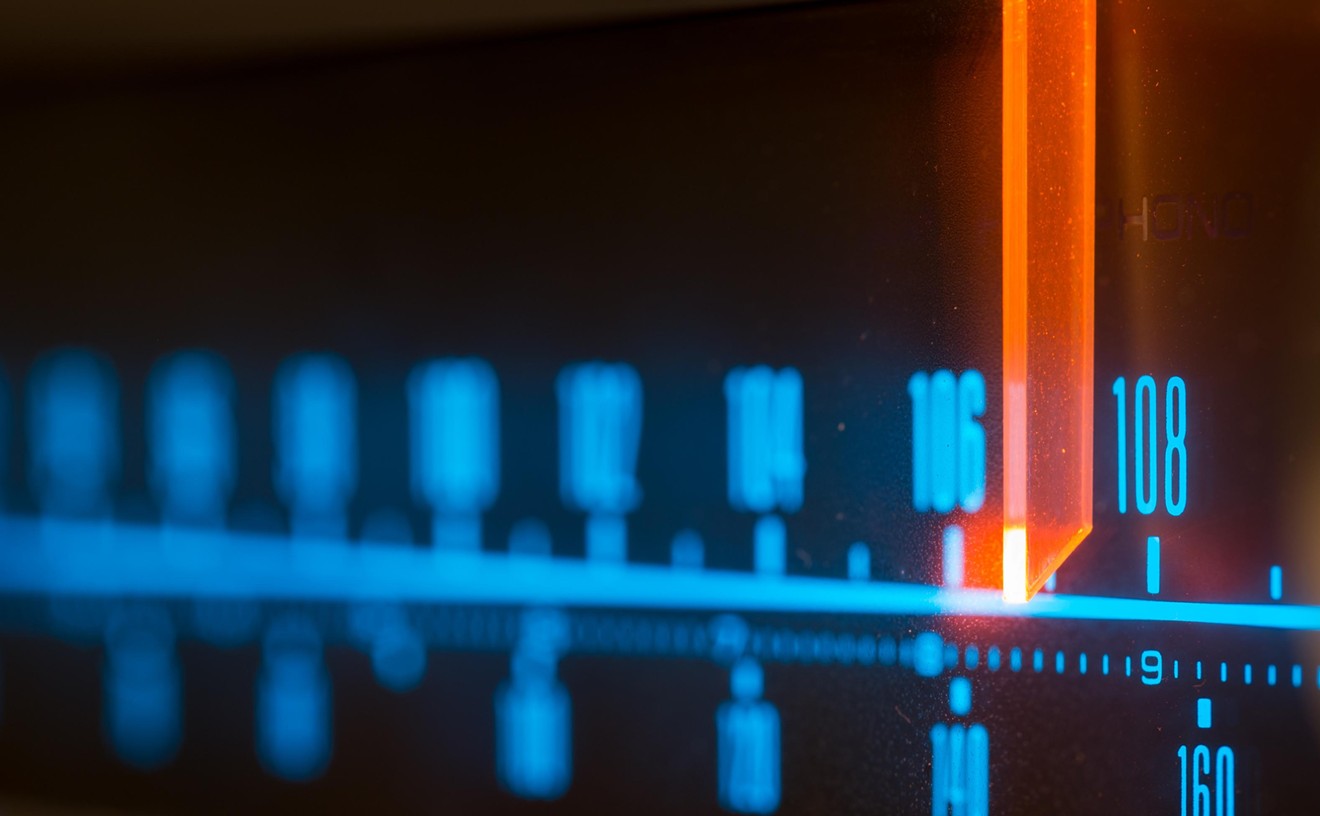See also: Former Friends of Young Americans Stream New Album, Estas Diluculo
Where we're going, we don't need roads; just a synthesizer, eyeliner, and a touch of androgyny. Welcome to Flashback Friday.
It may not be easy to lump locals Former Friends of Young Americans into any one specific genre, but if you listen closely, you can hear the subtle nuances provided by some of the band's '80s influences.
From the waning whimsy of The Cure, to the noise-wrangling pop rocking sounds of Sonic Youth, the untamed vocals of Siouxsie Sioux, and the jazz jams of A Tribe Called Quest; keyboardist Jessica Kelley, drummer Masa Schmalle, guitarist Matt Townsend and frontman Toby Fatzinger had plenty of inspiration.
FFoYA is currently working on a new album and has a string of shows lined up including a set at Filmbar on Friday, July 27, an appearance at Factories' July residency at Long Wong's on July 28, and one last local show at Lost Leaf on July 29 before they hit the road for a California coast tour.
Check out our email chat with the band as we discuss how they were impacted by the '80s.
Up on the Sun: Can you guys name some of the '80s music that guys like/liked listening to? Who were they and what did you like about them?
Matt Townsend: Throbbing Gristle. They were an avant-industrial band that actually split up in '81. They used found sounds, noise, and a lot of very edgy imagery -- especially for the time.
Sonic Youth was formed the same year Throbbing Gristle broke up. Way ahead of their time, they were one of the first bands I remember seeing that used two guitars, bass and drums to craft noise.
Sonic Youth's use of noise in a pop song was a huge awakening for me. I remember seeing them on some PBS special when I was like 16 and was blown away.
Toby Fatzinger: The Cure was huge. I absolutely loved those brooding melodies from the get-go. I loved all the subtle sounds and noises they weaved in and out of their well-crafted pop songs. I also loved the evolution of Joy Division to New Order. I was kind of a melancholy kid, so Joy Division's sound appealed to me right away. Then when I got into New Order, I was slightly embarrassed that I was so into this, basically dance music. But it was really good and those electronic beats just jumped right out at me. It totally popped and I was hooked, despite all the damage it did to my standing in the crowd of cool punk kids in high school.
The Cure resonated the most with me as a fan first, but in the long run they might actually be my largest musical influence. I absolutely loved Robert Smith's bass lines. His formula for songwriting allowed for so much space to sprinkle in keys, guitars and other instrumentation. They actually used noise to facilitate pop hooks, which still astounds me. In the 80's everything was guitar driven -- one dopey guitar riff after another. Robert Smith was one of the few, if not the only, that used guitars to sprinkle lovely textures throughout his tunes, built on technically simple but melodically intricate bass lines.
Jessie Kelley: I'm a chick and I've always been a sucker for girl bands -- especially 80's female artists like Siouxsie Sioux and Madonna. There is nothing better than a hot woman who can sing and put on a show. I grew up listening to and idolizing Madonna. That woman never stops reinventing her music or image. I remember dancing around my room blasting Madonna's "Vogue", pretending I was on the catwalk with a microphone in my hand. Another favorite was "Lucky Star". You have your bands that just play music. You have your bands that put on a show. Madonna put on a show.
I wasn't introduced to Siouxsie and the Banshees until a couple years ago. I was born in 1989, so I missed the 80's. A friend put on The Creatures' "Feast". I was immediately drawn to the crashing landscape from the percussion and Siouxsie's wild vocals. I then raided my friend's music cabinet and listened to every Creatures and Siouxsie and the Banshees album he had; which was every single release. From that day, my entire perspective of myself as an artist changed. I want to give people more than incredible music. I want to provide an experience at every show.
Her vocals are incredible, the lyrics are great and Budgie's percussion is perfect.
Masa Schmalle: A Tribe Called Quest was the first hip-hop group that really turned me onto a lot of other music outside of hip hop. I loved the jazzy rhythms and beats.
Jane's Addiction was another big one. They were abrasive, but rhythmically very groovy, which seems kind of silly now but was totally cool at the time. Perry Farrell was a weirdo which intrigued me. Seeing him dressed in drag, the band's image, the androgyny -- it was all very cool.
A Tribe Called Quest really sparked my interest in electronic, hip-hop and jazz music. They turned me onto a lot of hip hop and beat-oriented music that I continued to explore into the 90's and beyond. Before them, I was really just into metal and punk. I loved metal, but I think I was probably just into punk because it was just cool to be into when I was a kid. Ultimately, A Tribe Called Quest and the music I ended up getting into as a result of listening to them has had the most influence on my writing and playing.
How do these artists/songs resonate in the music you make today?
Townsend: Throbbing Gristle made me realize it's not technicality, but originality that matters to me. They made me understand noise and the power it has. I incorporate noise and try to be unique when writing and playing music today.
Thurston Moore and Lee Ranaldo of Sonic Youth both had a huge impact on my guitar playing. They used all these pedals and got all these noises out of them. They had a huge impact on me and still do.
Fatzinger: I definitely have a certain reverence for a well-thought-out and crafted bass line thanks to The Cure. That's such a noble instrument and totally ignored. Quite often, we'll write a bass line that can carry a song in a way that will allow us to fill in space with intricate noise patterns, vocals, keys, guitars and beats. This, in my opinion, is totally owed to Robert Smith as it's his template. The fact that he embraced pop music rather than abandon it for his image has also played a huge role in my development as a songwriter. Sometimes you just come up with something that's super poppy or maybe even cheesy. I learned from The Cure that you don't run from that, you roll with it. You find a way to make it different or interesting. Stretch it out, create space, add instrumentation, use the art of subtlety, think of it as a moving picture with a soundtrack. These are all things I learned from being a fan of The Cure.
Joy Division's Ian Curtis showed me that anyone can sing. What's more, he showed me that you don't need to be an over-the-top, less-than-genuine performer in order to sing. Joy Division showed me that creativity and persistence are far more important than an enigmatic front man. It's also more important than raw talent. The songs that they wrote in Joy Division were over-the-top cool, and I really doubt that they would've been as cool if the band was more talented. The way they developed as pop song writers in New Order and started to explore electronic beats, making real use of drum machines in the early '80s, was totally innovative and interesting. More than 25 years later we are trying to emulate those very danceable electronic beats with live drums. I also loved them for their use of synths in lieu of guitars. The same could be said for Depeche Mode. These bands really brought synths to the forefront as a viable musical instrument. There are certain sounds we try to create and make unique to our band through the use and augmentation of synth sounds. I often wonder what those guys would've come up with if they had the use of Ableton Live back then. I would like to think that's where we come in.
Kelley: I was inspired by Siouxsie's musical mess. I love the clanking of pans and different sources of sounds she uses and all of the strange off-time beats. I would say this influence is being introduced into FFOYA's music -- especially with the new album we are currently working on.
Schmalle: Since Tribe kind of opened up the floodgate of electronic music that I would end up getting into over the years, I guess you could say they have a lot to do with how I evolved musically. My drumming style mimics the electronic rhythms I hear, but the way that I play is a combination of jazz, electronic and rock kind of meshed into a live acoustic drum kit -- so the same could be said of Jane's Addiction too, I guess. Stephen Perkins' drumming style, his use of toms with limited use of cymbals, has definitely had an effect on the way I play.









